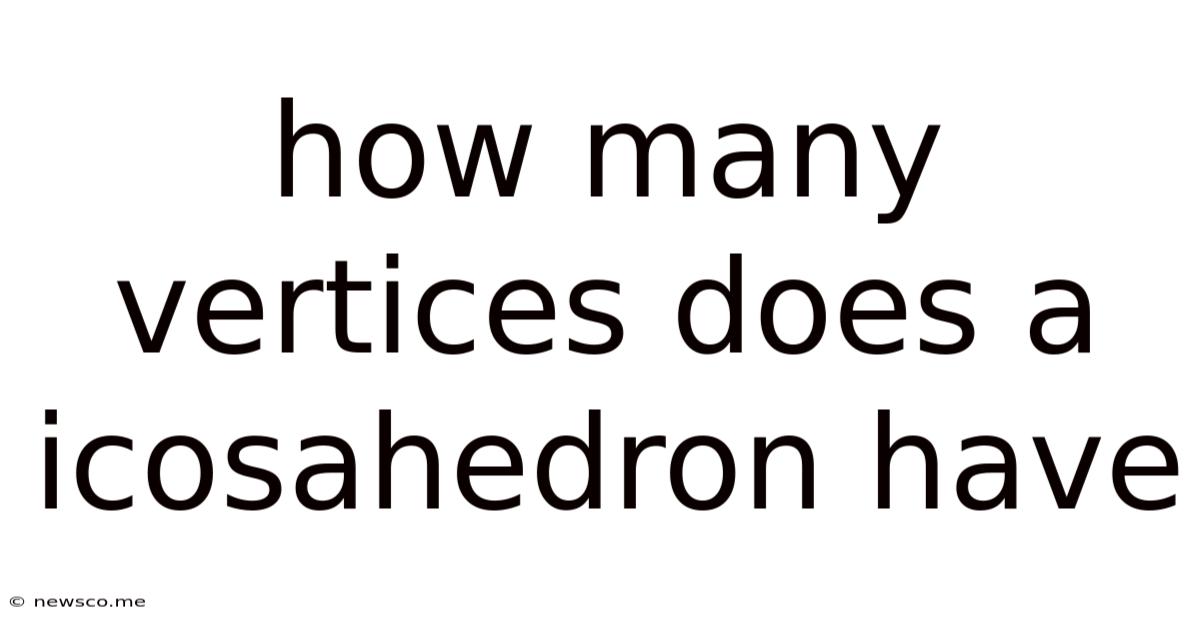How Many Vertices Does A Icosahedron Have
News Co
May 08, 2025 · 4 min read

Table of Contents
How Many Vertices Does an Icosahedron Have? A Deep Dive into Platonic Solids
The question, "How many vertices does an icosahedron have?" might seem simple at first glance. The answer, however, opens the door to a fascinating world of geometry, specifically the realm of Platonic solids – those perfectly symmetrical, three-dimensional shapes that have captivated mathematicians and thinkers for millennia. This article will not only answer the initial question definitively but also explore the properties of icosahedra, their relationship to other Platonic solids, and their significance in various fields.
Understanding Polyhedra and Platonic Solids
Before diving into the specifics of the icosahedron, let's establish a foundational understanding of polyhedra. A polyhedron is a three-dimensional solid shape composed of flat polygonal faces, straight edges, and sharp corners or vertices. Think of cubes, pyramids, and prisms – these are all examples of polyhedra.
Platonic solids, however, are a special subset of polyhedra. They possess exceptional symmetry:
- Regular faces: All faces are identical regular polygons (e.g., equilateral triangles, squares).
- Equal angles: The angles where faces meet are all equal.
- Equal edges: All edges have the same length.
There are only five Platonic solids:
- Tetrahedron: 4 faces (triangles), 4 vertices, 6 edges.
- Cube (Hexahedron): 6 faces (squares), 8 vertices, 12 edges.
- Octahedron: 8 faces (triangles), 6 vertices, 12 edges.
- Dodecahedron: 12 faces (pentagons), 20 vertices, 30 edges.
- Icosahedron: 20 faces (triangles), 12 vertices, 30 edges.
The Icosahedron: A Closer Look
Now, let's focus on the icosahedron. The word "icosahedron" derives from Greek roots: "icosa" (twenty) and "hedra" (faces). This perfectly encapsulates its defining characteristic: it has twenty equilateral triangular faces.
Answering the Question: How Many Vertices Does an Icosahedron Have?
The answer, as stated earlier, is twelve. Each icosahedron has precisely twelve vertices. These vertices are the points where five equilateral triangles meet. The arrangement of these triangles is what gives the icosahedron its unique and aesthetically pleasing symmetry.
Euler's Formula and Icosahedra
A crucial concept in understanding polyhedra is Euler's Formula, which states:
V - E + F = 2
Where:
- V represents the number of vertices.
- E represents the number of edges.
- F represents the number of faces.
For an icosahedron:
- V = 12
- E = 30
- F = 20
Applying Euler's Formula: 12 - 30 + 20 = 2. The formula holds true, demonstrating the inherent mathematical consistency of Platonic solids.
Icosahedra in the Real World and Beyond
Icosahedra are not just abstract mathematical concepts; they appear in various aspects of the real world and hold significance in several fields:
Nature's Geometry
Icosahedral symmetry is found in nature, albeit sometimes imperfectly. Certain viruses exhibit icosahedral capsids, which protect their genetic material. Some crystalline structures also display icosahedral symmetry. The nearly icosahedral shape of certain radiolarians (single-celled organisms) showcases nature's elegant use of this geometric form.
Architecture and Design
The structural strength and aesthetic appeal of the icosahedron have inspired architects and designers. Geodesic domes, popularized by Buckminster Fuller, often incorporate icosahedral structures to distribute weight effectively and create expansive spaces. The icosahedron's efficient use of material makes it a practical choice for these designs. You'll also find icosahedral shapes incorporated in art, jewelry, and various other design applications.
Games and Puzzles
The icosahedron's twenty faces make it ideal for creating games and puzzles. Twenty-sided dice (d20s), commonly used in role-playing games, are classic examples. Other puzzles and toys use icosahedral shapes to create challenging and engaging experiences.
Chemistry and Molecular Structures
Some molecules display icosahedral symmetry. Understanding these molecular structures is vital in various chemical fields. The symmetrical arrangement of atoms in these molecules impacts their reactivity and properties.
Exploring Related Platonic Solids
Understanding the icosahedron is made richer by exploring its relationships to other Platonic solids.
Dual Solids: The Dodecahedron
The icosahedron and the dodecahedron are dual solids. This means that if you connect the centers of the faces of one, you obtain the other. The vertices of the icosahedron become the centers of the pentagonal faces of the dodecahedron, and vice-versa. This duality highlights the interconnectedness within the family of Platonic solids.
Comparing Icosahedron to Other Platonic Solids
By comparing the icosahedron to the other Platonic solids (tetrahedron, cube, octahedron, dodecahedron), we can appreciate the unique properties that make it stand out. Its large number of faces and vertices, combined with its high degree of symmetry, sets it apart. The relationships between the number of faces, edges, and vertices in each solid provide fascinating insights into the underlying mathematical principles.
Conclusion: Beyond the Simple Answer
The simple answer to "How many vertices does an icosahedron have?" is twelve. However, this seemingly straightforward question serves as a gateway to a much deeper exploration of geometry, symmetry, and the remarkable world of Platonic solids. Understanding the icosahedron – its properties, its relationships to other shapes, and its presence in nature and human creations – reveals the elegant power and beauty of mathematics and its profound influence on our world. From the microscopic world of viruses to the macroscopic scale of architecture, the icosahedron's influence continues to shape our understanding of the universe around us. So next time you encounter this striking shape, remember the intricate mathematics and profound significance hidden within its seemingly simple twelve vertices.
Latest Posts
Related Post
Thank you for visiting our website which covers about How Many Vertices Does A Icosahedron Have . We hope the information provided has been useful to you. Feel free to contact us if you have any questions or need further assistance. See you next time and don't miss to bookmark.